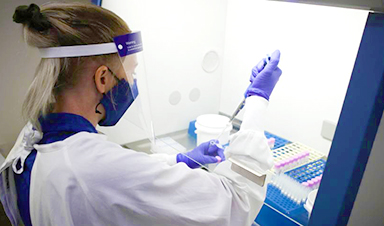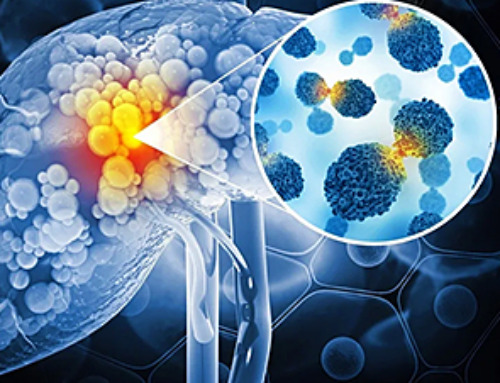| Serological tests play an important role in the surveillance and management of epidemics or pandemics, as well as in acquired immunity studies. Currently, COVID-19 serology is performed by well-established immunoassay techniques, which provide high sensitivities, but require specialized laboratories with trained personnel and processing times of 3 to 48 hours. | |
| A much faster and easier method is the lateral flow assay— such as the rapid diagnostic tests sold in pharmacies. However, the latter are not fully reliable, as they exhibit only moderate sensitivity and specificity. | |
| A team of researchers led by Prof. Laura M. Lechuga, CSIC Research Professor and head of the NanoBiosensors and Bioanalytical Applications Group at the Catalan Institute of Nanoscience and Nanotechnology (ICN2), has developed and extensively validated a novel serological nano-biosensor that provides a rapid (less than 15 minutes) identification and quantification of SARS-COV-2 antibodies in blood serum, without the need for sample pre-treatment and lengthy processing. It employs an optical sensing device based on a plasmonic technique that Prof. Lechuga’s group has been consolidating for years and has implemented for the diagnostics of diverse diseases and conditions –such as detection of cancer biomarkers, gluten ingestion or antibiotic allergy. |
| Extensive testing on clinical samples, provided by the Vall d’Hebron University Hospital and the Hospital Clínic of Barcelona–IDIBAPS during the first months of COVID-19 pandemic, was performed to prove the efficacy and reliability of this biosensor technology. In particular, 120 samples of serum were used, of which 100 from confirmed COVID-19 positive patients and 20 negative ones (collected prior to the outbreak of the pandemic). Comparative analyses with standard techniques and commercial lateral flow assays showed that this plasmonic biosensor technology outperforms well-established diagnostic methods, providing excellent sensitivity (99%) and specificity (100%). | |
| Such remarkable accuracy and the short operation times (the result is available in less than 15 minutes) make of this new biosensor an outstanding tool for rapid and reliable serological tests. Fast and quantitative serology is crucial for monitoring the evolution of the COVID-19 pandemic, managing patients’ hospitalization and placement in intensive care units and assessing the immunological status of individuals during vaccination campaigns and in the presence of emerging variants of the virus. | |
| Since the read-out device is compact and the procedure can be automatized, this technology has also potential for point-of-care applications and could be introduced in doctors’ practices and pharmacies. In addition, the same technique can be employed for the detection of various substances in body fluids –such as gluten peptides, early cancer biomarkers, anticoagulant drugs, or antibiotic allergy antibodies — thus, for the diagnostics and monitoring of many diseases. | |
| The readiness level of this technique is already very high and their developers are committed to achieve a fast technology transfer to industry, in order to introduce this new biosensor device both in the clinical environment and in decentralised settings. Watch this animation illustrating how a portable read-out device with disposal cartridges would work. | |
| The results of this study, carried out in the framework of the EU funded project CoNVaT, have been published in Analytical Chemistry (“Label-Free Plasmonic Biosensor for Rapid, Quantitative, and Highly Sensitive COVID-19 Serology: Implementation and Clinical Validation”). The research has been developed by Prof Lechuga’s group in collaboration with the Intensive Care and Clinical Microbiology Departments of the Vall d’Hebron University Hospital (Barcelona, Spain), the Department of Pneumology of the Hospital Clínic of Barcelona-IDIBAPS, and the Emerging Virus Unit of Aix-Marseille University (France). Senior researchers Dr Maria Soler and Dr M. Carmen Estévez are the corresponding authors, while PhD student Olalla Calvo-Lozano is the first author, having performed the optimization and validation of the system. |
News
The Stunning New Push to Protect the Invisible 99% of Life
Scientists worldwide have joined forces to build the first-ever roadmap for conserving Earth’s vast invisible majority—microbes. Their new IUCN Specialist Group reframes conservation by elevating microbial life to the same urgency as plants and [...]
Scientists Find a Way to Help the Brain Clear Alzheimer’s Plaques Naturally
Scientists have discovered that the brain may have a built-in way to fight Alzheimer’s. By activating a protein called Sox9, researchers were able to switch on star-shaped brain cells known as astrocytes and turn them into [...]
Vision can be rebooted in adults with amblyopia, study suggests
Temporarily anesthetizing the retina briefly reverts the activity of the visual system to that observed in early development and enables growth of responses to the amblyopic eye, new research shows. In the common vision [...]
Ultrasound-activated Nanoparticles Kill Liver Cancer and Activate Immune System
A new ultrasound-guided nanotherapy wipes out liver tumors while training the immune system to keep them from coming back. The study, published in Nano Today, introduces a biodegradable nanoparticle system that combines sonodynamic therapy and cell [...]
Magnetic nanoparticles that successfully navigate complex blood vessels may be ready for clinical trials
Every year, 12 million people worldwide suffer a stroke; many die or are permanently impaired. Currently, drugs are administered to dissolve the thrombus that blocks the blood vessel. These drugs spread throughout the entire [...]
Reviving Exhausted T Cells Sparks Powerful Cancer Tumor Elimination
Scientists have discovered how tumors secretly drain the energy from T cells—the immune system’s main cancer fighters—and how blocking that process can bring them back to life. The team found that cancer cells use [...]
Very low LDL-cholesterol correlates to fewer heart problems after stroke
Brigham and Women's Hospital's TIMI Study Group reports that in patients with prior ischemic stroke, very low achieved LDL-cholesterol correlated with fewer major adverse cardiovascular events and fewer recurrent strokes, without an apparent increase [...]
“Great Unified Microscope” Reveals Hidden Micro and Nano Worlds Inside Living Cells
University of Tokyo researchers have created a powerful new microscope that captures both forward- and back-scattered light at once, letting scientists see everything from large cell structures to tiny nanoscale particles in a single shot. Researchers [...]
Breakthrough Alzheimer’s Drug Has a Hidden Problem
Researchers in Japan found that although the Alzheimer’s drug lecanemab successfully removes amyloid plaques from the brain, it does not restore the brain’s waste-clearing system within the first few months of treatment. The study suggests that [...]
Concerning New Research Reveals Colon Cancer Is Skyrocketing in Adults Under 50
Colorectal cancer is striking younger adults at alarming rates, driven by lifestyle and genetic factors. Colorectal cancer (CRC) develops when abnormal cells grow uncontrollably in the colon or rectum, forming tumors that can eventually [...]
Scientists Discover a Natural, Non-Addictive Way To Block Pain That Could Replace Opioids
Scientists have discovered that the body can naturally dull pain through its own localized “benzodiazepine-like” peptides. A groundbreaking study led by a University of Leeds scientist has unveiled new insights into how the body manages pain, [...]
GLP-1 Drugs Like Ozempic Work, but New Research Reveals a Major Catch
Three new Cochrane reviews find evidence that GLP-1 drugs lead to clinically meaningful weight loss, though industry-funded studies raise concerns. Three new reviews from Cochrane have found that GLP-1 medications can lead to significant [...]
How a Palm-Sized Laser Could Change Medicine and Manufacturing
Researchers have developed an innovative and versatile system designed for a new generation of short-pulse lasers. Lasers that produce extremely short bursts of light are known for their remarkable precision, making them indispensable tools [...]
New nanoparticles stimulate the immune system to attack ovarian tumors
Cancer immunotherapy, which uses drugs that stimulate the body’s immune cells to attack tumors, is a promising approach to treating many types of cancer. However, it doesn’t work well for some tumors, including ovarian [...]
New Drug Kills Cancer 20,000x More Effectively With No Detectable Side Effects
By restructuring a common chemotherapy drug, scientists increased its potency by 20,000 times. In a significant step forward for cancer therapy, researchers at Northwestern University have redesigned the molecular structure of a well-known chemotherapy drug, greatly [...]
Lipid nanoparticles discovered that can deliver mRNA directly into heart muscle cells
Cardiovascular disease continues to be the leading cause of death worldwide. But advances in heart-failure therapeutics have stalled, largely due to the difficulty of delivering treatments at the cellular level. Now, a UC Berkeley-led [...]





















